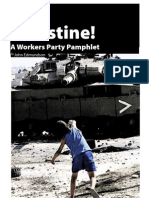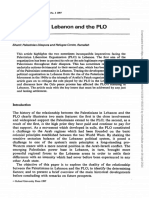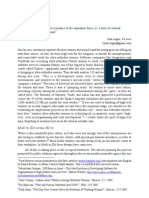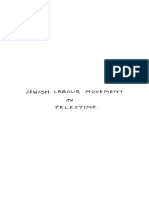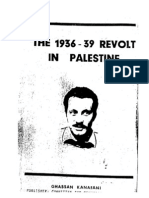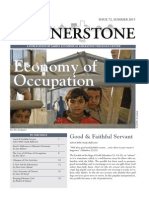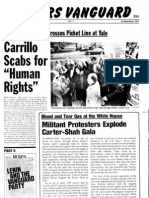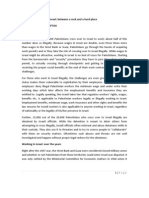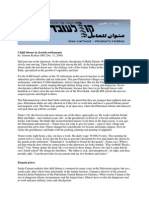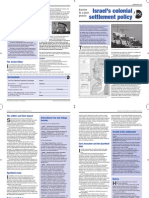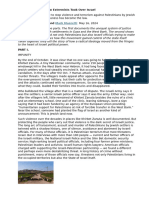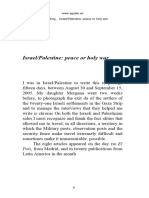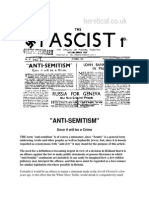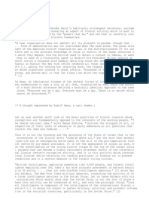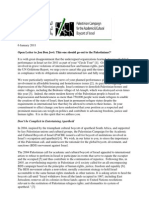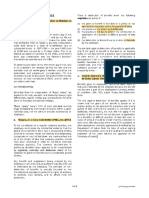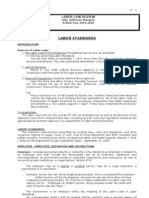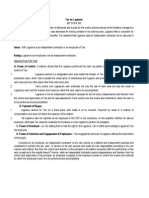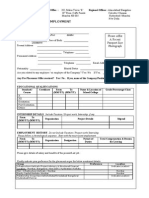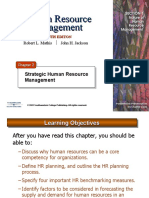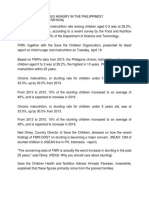Palestinian Workers, A Reserve Army of Labour in The Israeli Economy - Introduction Emmanuel Farajun - Matzpen - Org - English
Palestinian Workers, A Reserve Army of Labour in The Israeli Economy - Introduction Emmanuel Farajun - Matzpen - Org - English
Uploaded by
tawfiqCopyright:
Available Formats
Palestinian Workers, A Reserve Army of Labour in The Israeli Economy - Introduction Emmanuel Farajun - Matzpen - Org - English
Palestinian Workers, A Reserve Army of Labour in The Israeli Economy - Introduction Emmanuel Farajun - Matzpen - Org - English
Uploaded by
tawfiqOriginal Title
Copyright
Available Formats
Share this document
Did you find this document useful?
Is this content inappropriate?
Copyright:
Available Formats
Palestinian Workers, A Reserve Army of Labour in The Israeli Economy - Introduction Emmanuel Farajun - Matzpen - Org - English
Palestinian Workers, A Reserve Army of Labour in The Israeli Economy - Introduction Emmanuel Farajun - Matzpen - Org - English
Uploaded by
tawfiqCopyright:
Available Formats
עברית ﻋرﺑﻰ Français
About The Other Israel ISRACA Khamsin Articles Documents Photo Album Video
Previous Next
Palestinian Workers, A Reserve Army of Labour in the Israeli
Economy: Introduction ‒ Emmanuel Farajun
July 10, 1980 | Categories: Articles, Forbidden Agendas, Khamsin 7 | Tags: Emmanuel Dror Farajun
By Emmanuel Farajun, Tel Aviv, July 1979. Originally published in Hebrew by The Israeli Socialist
Organization (MATZPEN) in “Dapim Adumim” (“Red Pages”), no 5, May 1978.
Palestinian Workers, A Reserve Army of Labour in the Israeli
Economy
Introduction
Chapter-1: The Arab working class Monthly Archives
Chapter-2: The division of the Arab labour force between occupations
and enterprises
Select Month
Chapter-3: Mobility
Chapter-4: Wages and working conditions
Introduction
In Israeli society the term “Arab”, i.e. a member of the Arab society in the
territory occupied by Israel has a two-fold meaning: firstly, the Arab as a
person, born and bred in Palestinian-Arab society, is a non-Jewish inhabitant
of a Jewish State, and secondly, the Arab as a worker, arriving to work early in
the morning from his village, building houses and roads, cleaning, gardening,
fixing cars, pumping petrol and returning home at night – to the West Bank, the
Gaza Strip, the Galilee or the Triangle. The Arab as a person is most
loathsome. His mere existence is a threat to the Jewish character of the State
of Israel. He belongs to the Arab nation, against which the colonising Jewish
society has been struggling since its infancy. As the writer A.B. Yehoshua puts
it: “That is why this nation was warned to remain alone, virtually alone,
separated from the nations surrounding it… there is nothing more dangerous
than embracing these nations into our midst (and they are in our midst, they
are entirely woven in our economic infrastructure and encroaching into other
areas, too…)”.1 The Arab as a person is persecuted and hated in Israeli
society. All sorts of means are sought to hide his existence and even to expel
him. He cannot join a kibbutz or a moshav – the plume feather in Israel’s
bonnet; most Israeli cities and Jewish settlements are closed to him by force of
local regulations and state laws (in the whole of Israel there are only six
settlements with a mixed Arab and Jewish population); at night, after work, he
cannot walk about freely in the streets of Tel Aviv. He has to huddle in dark
corners, lock himself in at night or return home to his village. The term “Arab”
does not even appear in official Israeli statistical publications, according to
which there is only one nationality in Israel – the Jews; the rest are “the
minorities”, “non-Jews”, “Christians”, “Druze” and so forth. The Arab worker,
however, is welcome everywhere In Israeli society – and this enrages “liberals”
like A.B. Yehoshua.
In the kitchens and gardens of the Israeli elite, where he cooks, cleans and
prunes, through building sites, petrol stations, carpentry shops and factories
and even in army camps. The abolition of daily passes and structural changes
in the Military Government in 1966, enabled many Arab workers to move
relatively freely (except in the southern region); the gates so to speak, opened
wide for him. The Histadrut (General Federation of Labour), a cornerstone of
the Israeli establishment, not only allowed him in for the first time since its
establishment in 1920, but also changed its name from the General Hebrew
Federation of Labour to the General Federation of Labour for his behalf. As we
shall see the Arab worker became a decisive factor in the major sectors of the
Israeli economy: in the construction industry, in road building, in tourism,
agriculture and various other industries. He is gradually moving into many
typical Israeli industrial production areas: food processing, textile industries,
building material manufacture and many other industries. We shall attempt in
this survey to describe the characteristics of Arab labour power in Israel. We’ll
ignore, in other words, as far as possible, the Arab as a person, as a citizen
and as a member of the Arab-Palestinian nation, though this constitutes a
vitally important aspect of the national and class structure of Israeli society.
We’ll try to focus on the role of the Arab worker in Israel’s economy – workers
both from inside the “green line” and from outside it, i.e. from the West Bank
and the Gaza Strip. The obvious difficulty of distinguishing between the two
aspects and isolating the economic side of the story is illustrated in the
following honest journalistic account, written by Ya’ir Kottler in an article about
the civil guard and its role as the guardian of Jewish purity in Tel-Aviv:
“The time is two hours before midnight. In a back seat of the
jeep there are two young armed volunteers (civil guards). Their
mission – to comb Shuk HaKarmel (the Tel Aviv central
market). They are searching for Arabs spending the night in
Tel Aviv – in tiny nooks, on building sites, in warehouses, even
behind greengrocers’ counters. They are not supposed to stay
on in the Jewish city beyond one a.m. unless they have
special permits which most of the workers from the occupied
territories, flooding Tel Aviv and the neighbouring
municipalities do not have… The civil guard is helping the
police. The frightened Arabs, unaware of the police-type-
authority of this civil militia, answer questions and show their
papers. They are harassed. They are temporarily detained in a
base near a large school. Although they cannot be arrested
before one A.M., they can be harassed. This is precisely what
is done. The district police chief, commander Moshe Tiomkin,
says in an interview, that in his district, which contains 1.1
million people, there are already some 70.000 Arabs from the
occupied territories – 50 per cent of whom work In Tel Aviv
proper. This is an undoubtedly astonishing figure. The police
cannot cope with the problem. They seek the help of the civil
guard. But the volunteers have not joined the guard in order to
become semi-official policemen, hunting and interrogating
Arab workers seeking shelter from the law in fox holes, in
locked poultry shops, in back yards and in rented rooms in
Jewish houses. ‘Can we detain thousands? If we do this’, says
Tiomkin, ‘we shall be the first to suffer. The following morning
the big city will lose its workers. They are building the city’. If
they are detained no one will clean the streets… Somewhere
near the beach we stopped three Arabs. One was terrified – he
had no papers – he came to work with a friend from Hebron.
The Hebronite, 19 years old, has been working in Tel Aviv for
the last 5 years, mostly as a night watchman, earning 70 IL per
day, sometimes more. He wouldn’t give up his work in Tel Aviv
for a state of his own. He simply fell in love with the Jewish
city, with its girls and its entertainment spots. Jews aren’t
workers – he says, adding that Shuk HaKarmel is full of Arabs
from Gaza. Commander Tiomkin is of the opinion that the
increase in crime in the district, particularly in Tel Aviv, is partly
a result of there being tens of thousands of Arabs from the
occupied territories there. They remind him of a ‘slave
market’.”2
This essay does not, in fact, deal with the overall role of the Palestinian-Arabs
in the Israeli economy but examines their contribution as workers, be it
labourers, self-employed workers or skilled workers, since the Arab labour
power in Israel operates mainly within the bounds of salaried or a self-
employed work. The capitalist stratum within Arab society is very limited and
there are virtually no Arabs in administrative positions. Arab society in Israel
has a limited economic base: according to official reports3 there were only
three Arab-owned industrial enterprises in Israel in 1976. Israeli economic-
politics does not permit factories to be opened without active government aid.
But State institutions do not permit even the most consistent of the
collaborationist villages to develop Arab-owned industrial zones (see, for
example, an article about Kafer Qana, Ha’aretz, Nov. 4, 1977). Two of the
existing enterprises are small sewing workshops and the third is a metal
factory (200 employees) in Yarka, in the Galilee. Even if one or two other
enterprises were founded during the last few years, the fact remains that there
is no Arab capitalist bourgeoisie in Israel. Moreover, Jewish-Israeli enterprises
in Arab villages are few and far between according to the latest reports there
are some 50 small enterprises, mostly sewing workshops and carpentry shops.
The Arab bourgeoisie is a petit-bourgeoisie made up of merchants and
farmers. More than 70 per cent of the total Arab labour force is made up of
salaried workers, mostly in production: construction, agriculture, industry and
services, i.e. hotels, restaurants, etc. Only a small proportion work as clerks, or
in the public services, in finance or in the professions. One must conclude that
the Arabs’ almost exclusive contribution to the Israeli economy is as productive
workers, from whose labour someone – a contractor, an industrialist, a
businessman – profits directly. Only a few of them are self-employed: farmers,
sub-contractors and so on.
The unique role of the Arab worker
If we follow the growth of this labour force, its composition, the sectors in which
it is concentrated and its socio-economic characteristics, we shall discover that
there is a definite regularity in the growth of the Arabs’ place and role in the
economy. During the history of Zionist settlement in Israel the Jews tried as a
rule, to create a society based on the purity of Jewish labour, at least in some
focal sectors. But the natural development of a capitalist economy as well as
constant clashes with the Arab world concentrated the Jewish worker more
and more in purely strategic production. At first this meant agricultural
production – settling on the land, erecting Jewish colonies, moshavim and
kibbutzim whereever possible – (the rules of the Jewish National Fund [JNF]
were drawn up to this end: to forbid the sale, lease of its lands, or the right to
work them, to non-Jews). Other such sectors were the diamond industry, the
ports etc. With the establishment of the state and the deportation of many
Arabs from hundreds of villages came the expropriation of most of the Arab
lands in order to sieze control of the Arabs’ main property – the land, as an
important step towards the total control of agricultural production. On the other
hand, with the increase of the Arab population remaining under Israeli rule
(more than half that population was “aquired” by Israel as a result of the
Rhodes agreements and the change in the cease-fire line in the area of the
Triangle and Wadi ‘Ara) from 160,000 at the end of 1949, 400,000 in 1967, to
550,000 in 1978 – the pressure of workers willing to work for low wages and in
bad conditions, made itself felt.
At the same time, an important change occurred in the Israeli economy with
the developing Israeli armament industry in the sixties, particularly after
decisive changes both in the geography of the country and in the allignment of
powers resulting from the June ’67 war – changes which brought a huge flow
of capital into Israel, turning it from a privileged protegè of the West into an ally
with a local council status. Following these changes, agriculture ceased to fulfil
a strategic role and the accelerated economic development both in agriculture
and in industry created an ever increasing demand for a cheap, mobile and
under-privileged labour force: a free labour force in the classical economic
sense of the term. This role was filled by the Arab worker, both in the new
territories just annexed to Israel and by “Israeli” Arab workers, just starting to
flow into the market in large numbers.
Because of the need to sustain a colonising society, living sword in hand, in
constant conflict with the world around it, it became necessary to grant the
Jews full privileges and to try and maintain, at all costs, a high standard of
living for them, in order to prevent emigration (“Yeridah“) and help create a
maximal state of political stability. In order to meet this demands, the freedom
of action towards the Jewish workers, especially on the part of the bourgeoisie
in government, i.e. the Avodah (Labour) party and Mapam (the bourgeoisie of
the public-beaurocratic economy), must be curtailed. Secure employment and
salary, a standard of living higher than that of the surrounding Arab world,
became a cornerstone of the Israeli political system. Thus post ’67 accelerated
economic development created the above mentioned demand for “free” labour,
i.e. cheap, mobile, impermanent and lacking political representation – a
demand which could not be met by Jewish workers.
Post ’67 military and political development also created a huge demand for
Jewish labour power in the armament industry, in the army and in the general
administration of the territories recently occupied. The inevitable result was
that the Arab labour force started taking an active role within this free labour, in
the above mentioned sense, at the disposal of the Israeli economy, which until
then was mostly made up of oriental Jews. We will show that since ’67 it has
become, – together with the lowest strata of the Jewish proletariat, made up
mainly of oriental Jews, – a major and indispensable element of the Israeli
economy.
Israeli civil industry, particularly the private sector, is becoming dependent on
Arab labour power. The ethnic division in the territories governed by Israel is
becoming more and more economically significant: on one hand there is a
privileged group, working in industries and State services, the army and
strategic industries – a shielded group, with a certain monopoly, immobile, hard
to fire and whose working conditions are constantly being improved through
organised struggles and political pressures (the Histadrut, the AVODAH party,
etc.); and on the other hand the free part of the working class, granting the
economy its flexibility, its capacity to adjust to crises. The latter group turns the
manpower reservoir into a labour market in the classical capitalist sense and
is, as denotes the title of this work: the reserve force of the Israeli economy. At
the same time, this free labour makes the private bourgeoisie, both in
agriculture and in industry, independent of the Histadrut, the State bodies and
the bureaucracy.
This force is one of the sources of strength of the private bourgeoisie, as
opposed to the State-bureaucratic bourgeoisie (i.e. the Histadrut, the
kibbutzim, etc.) The Histadrut cannot attack a private businessman employing
Arabs by applying pressure or by strikes – since everybody is in the same boat
regarding the Arabs. A strike by Arab workers would endanger both sectors.
Moreover, due to the relative abundance of Arabs in the Israeli economy, their
maneuverability is limited and their bargaining powers almost nil. Thus Arab
labour has contributed to strengthening the private bourgeoisie in Israel in
relation to the State-bureaucratic bourgeoisie. This causes some rather
ridiculous situations in which representatives of the State-bureaucratic
bourgeoisie like A.B. Yehoshua, a “leftwing” Zionist – talk and act more
dogmatically, more firmly and with more racist jingoism against the “Arab
presence” in Israel than their counterparts on the right – some of whom would
like the two nations to live together – under Zahal’s iron hand, of course.
The survey and its chapters
This survey, for the most part, is made up of statistics. It tries to chart the
growth of the Arab working class in Israel and its present position, using Israeli
official publications and to a lesser degree, occasional articles published in the
Israel press. The figures, though indicative, tell only a small part of the story of
the Arab workers in Israel. Only a full sociological survey could tell the whole
story. A short visit to some Israeli towns would reveal that figures could never
describe the situation. Be’er-Sheva, for example – a town “washed clean” of its
pre-1948 Arab inhabitants, like hundreds of other towns and villages captured
by the Israeli army during the war – and which now has a population of
100,000, attracted over the years thousands of Bedouin-Arab workers from all
over the Negev. Most of these Arabs were Fellahin, driven off of their lands by
the kibbutzim and moshavim whose aim was, to “make the desert bloom”.
These workers cannot, of course, live in Be’er-Sheva: the houses they build
are not destined for Arabs but for new immigrants, for Jewish workers etc. As a
result, Be’er-Sheva is now surrounded by a belt of tin huts where the Arab
workers live. These townships, from which the workers emerge in order to
build Be’er-Sheva and work in its factories, are not serviced by water,
sewerage, electricity, or roads. Like the black townships in South Africa, their
very existence is illegal and with the expansion of the town they will no doubt
be pushed out, beyond the city boundaries. Such townships tell more about
these workers than any list of figures. They are to be seen on the fringe of
other cities in Israel, like Ramleh and Haderah.
The government and its “settlement minister”, Ariel Sharon, keep reminding us
that tens of thousands of Bedouins have “infiltrated into the coastal plain” –
into the heart of the Jewish state. Mister Sharon forgets that these very same
Bedouin infiltrators fill his car with petrol, work on his large agricultural farm
and that without their “infiltration” many Israeli enterprises, including many
export lines, would have to close down. But this survey does not touch upon
any of the above mentioned social aspects. The survey has four chapters: the
first chapter deals with the working population as a whole and with the reserve
force of the Israeli economy. It seems that the Jewish industrial reserve force in
Israel has largely diminished – all skilled and semi-skilled workers are fully,
though not always efficiently, employed – despite the five years recession,
since the ’73 war. The manpower problem is of course related to the general
population balance between the two nationalities: the Israeli and the
Palestinian. In this chapter we shall see, for instance, that the growth of Arab
labour is twice that of Jewish labour.
The second chapter deals with the division of Arab labour, both from the
territories and from Israel, into various sectors and enterprises. It seems that in
the heavy industries, where direct profit is made, the Arabs contribute more
than their proportion in the population and in the general labour force. We shall
also try to estimate their relative contribution to the overall production of Israeli
workers.
The third chapter reviews an important characteristic of the Arab working class
– its mobility which distinguishes it from the Jewish proletariat. This very
mobility makes it a “free” labour power, economically speaking, totally effected
by the fluctuations of the market. The recent recession which did not bring
about unemployment in the Jewish sector, dramatically reduced the number of
Arab workers, particularly from the West Bank, working in Israel.
The fourth chapter deals with salaries and working conditions. This chapter is
on the borders of statistical research and in order to fully cover this subject one
has to study the social conditions of the Arab working class – which is beyond
the scope of this work. It seems, however, that not only the income per capita
of the Arab working class is half the income per capita of the Jewish (salaried)
working class, but also that within each occupation there is a difference of 25-
40 per cent between the salaries of Arab and Jewish workers.
Continue to… Chapter-1: The Arab working class
1. “Bitfutzot Hagolah” (in the Diaspora), 1975-6. p. 38 ↩
2. Ya’ir Kottler, Ha’aretz, 9.9.1977 ↩
3. H. Harari, “Israeli Arabs, 1976, in figures“. Giv’at Havivah – Arab
Research works. No. 10 ↩
PEOPLE
'Adil Samara (6) A. Ender (1) A. Israéli (1)
Abraham Serfaty (2) Ahmad Jibril (1) Ahmad Massarweh (1)
Akiva Orr (15) Akram Kand (1) Alain Hertzmann (2)
Alexander Flores (3) Ali Ashtiani (1) Ali J (1) Aliza Dror (1)
Allan Salomonow (1) Amos Kenan (1) Arie Bober (3)
Aryeh Finkelstein (1) Avishai Ehrlich (7) Aviva Ein-Gil (1)
Azar Tabari (6) Ben Cashdan (1) Bertrand Russell (1)
Beverly Woodward (1) Clive Bradley (1) Dan Diner (1)
Daniel Machover (2) David Deitch (1) David Nussbaum (1) Home
Debbie Lerman (1) Dina Hecht (1) Dina Stein (1) Dov Gal (1)
Contact Us
Dov Goldstein (1) Dov Schoss (1) E. Solomon (1)
Link to Us
Ehud Ein-Gil (8) Eli Aminov (1) Eli Lobel (17)
Terms of Use
Elmer Berger (1) Emmanuel Dror Farajun (12) Eqbal Ahmad (1)
Eran Torbiner (8) Erich Fried (1) Everett Gendller (1)
Fauzi El-Asmar (1) Fred Halliday (1) Fuad Faris (1)
Gabriel A. David (1) Ghada Karmi (1) Giyora Neumann (2)
Haim Bresheeth (3) Haim Hanegbi (6) Haim Scortariu (2)
Hamida Kazi (1) Howard Zinn (1) Ibn Alwalid (1)
Igal Roodenko (1) Ilan Halevi (1) Ilana Machover (1)
Irène Gendzier (2) Irène L. Gendzier (1) Irith Yaakobi (1)
Israel Shahak (10) Jabra Nicola (7)
Jacqueline Farhoud Jraissaty (1) Jamil Hilal (1) Jayne Peters (1)
Joe Stork (1) John Bunzl (1) Jon Rothschild (6)
Lafif Lakhdar (3) Laila al-Hamdani (2) Lazare Rozensztroch (1)
Lea Tsemel (2) Leila Kadi (3) Les Levidow (1) M. Arman (1)
M. Ja'afar (5) M. Varshevsky (1) Magida Salman (4)
Mai Ghoussoub (3) Mario Offenberg (2) Martin Barzilai (1)
Maryam Poya (2) Maxime Rodinson (4) Maxine Molyneux (1)
Maya Cohen (1) Meir Smorodinsky (1) Michael Robinson (1)
Michel Warschawski (1) Mike Tabor (1) Mikhal Marouan (3)
Mohammad Ja'far (2) Mony El-Kaïm (1) Moshé Machover (47)
Musa Budeiri (2) N. Israeli (3) Nabil Saad (1) Nada Cadir (2)
Nathan Weinstock (1) Nigel Disney (1) Nira Yuval-Davis (7)
Nisan Rilov (1) Noam Chomsky (1) Norton Mezvinsky (1)
Nur-eldeen Masalha (1) Oded Pilavsky (3) Patrick Clawson (1)
Paul Jacobs (1) Pembenaz Yorgun (1) Philip Schlesinger (1)
Pierre Vidal-Naquet (1) R. Keivan (1) Rami Heilbronn (4)
Rami Livneh (1) Raphael Shapiro (2) Reuven Lassman (1)
Richard Marienstras (1) Richard Thomas (1) Roberto Matta (2)
Roberto Sussman (1) Ron Ayres (1) Rosemary Sayigh (1)
Roslyn Zinn (1) S. Ur (1) Sa'adia Marciano (1)
Sadik Jalal al-'Azm (3) Said Hammami (3) Salim Tamari (1)
Salma Botman (1) Samir Amin (1) Saül Neguev (1)
Shabtai Tevet (1) Shaher Sa'ed (1) Shimon Tzabar (8)
Shlomo Fraenkel (1) Shulamit Aloni (1) Suliman Bashear (1)
Suzy Barry (3) Tareq Aunallah (1) Tikva Honig-Parnass (1)
Toby Shelley (4) Toine van Teeffelen (1) Tony Greenstein (1)
Turgut Taylan (1) Udi Sivosh (1) Uri Avneri (1) Uri Davis (1)
Uri Harari (1) Victor Tracz (1) Ya'acoub Daoud Eskandarany (1)
Yasser Ali (2) Yehoshua Bar-Yosef (1) Yeshayahu Ben Porat (1)
Yoël Levy-Corcos (1) Yolla Polity Sharara (1)
You might also like
- NCM 120 Decent Work Employment and Transcultural NursingDocument18 pagesNCM 120 Decent Work Employment and Transcultural NursingFrancia Toledano67% (3)
- Hollow Land: Israel’s Architecture of OccupationFrom EverandHollow Land: Israel’s Architecture of OccupationRating: 4.5 out of 5 stars4.5/5 (13)
- Free Palestine! Workers Party (NZ) PamphletDocument48 pagesFree Palestine! Workers Party (NZ) PamphletMichael Walker0% (1)
- Breaking The Lies by David WilderDocument51 pagesBreaking The Lies by David WilderDavid WilderNo ratings yet
- The Mizrahi Era of Rebellion: Israel's Forgotten Civil Rights Struggle 1948-1966From EverandThe Mizrahi Era of Rebellion: Israel's Forgotten Civil Rights Struggle 1948-1966Rating: 4 out of 5 stars4/5 (1)
- Capitalist Colonial: Thai Migrant Workers in Israeli AgricultureFrom EverandCapitalist Colonial: Thai Migrant Workers in Israeli AgricultureNo ratings yet
- Palestinians in Lebanon and The PLO: Abbas ShiblakDocument14 pagesPalestinians in Lebanon and The PLO: Abbas Shiblakkarim-achy99No ratings yet
- Israel in A NutshellDocument8 pagesIsrael in A NutshellNishant ShahNo ratings yet
- Second Asia Pacific CongressDocument32 pagesSecond Asia Pacific Congressapi-170175919No ratings yet
- Matrix in Bil inDocument15 pagesMatrix in Bil inShakedi SermonetaNo ratings yet
- HAIFA Intercultural ProfileDocument18 pagesHAIFA Intercultural ProfileStanisław LemkeNo ratings yet
- The Jewish Labour MovementDocument74 pagesThe Jewish Labour MovementAndreea UrsacheNo ratings yet
- Jewish Organizations For Self Defense in Yishuv (Jewish Comunities in Palestina)Document14 pagesJewish Organizations For Self Defense in Yishuv (Jewish Comunities in Palestina)Vasile Mesaros AnghelNo ratings yet
- Workers Vanguard No 159 - 27 May 1977Document12 pagesWorkers Vanguard No 159 - 27 May 1977Workers VanguardNo ratings yet
- Essay-Final Draft On Israel Arabs and PalestineDocument10 pagesEssay-Final Draft On Israel Arabs and PalestineTariq SulemanNo ratings yet
- Field Notes From PalestineDocument10 pagesField Notes From PalestineAndrew B.No ratings yet
- In West Bank Settlements, Israeli Jobs Are Double-Edged Sword PDFDocument6 pagesIn West Bank Settlements, Israeli Jobs Are Double-Edged Sword PDFalecvaldezNo ratings yet
- The Koenig ReportDocument12 pagesThe Koenig ReportMed1aN1ckNo ratings yet
- Everything About LebanonDocument10 pagesEverything About Lebanonnaxton10No ratings yet
- Giladi - Discord in Zion - Conflict Between Ashkenazi and Sephardi Jews in Israel (1990)Document371 pagesGiladi - Discord in Zion - Conflict Between Ashkenazi and Sephardi Jews in Israel (1990)Rosario Dei Medici100% (1)
- The UnpunishedDocument49 pagesThe UnpunishedAhmad ZureiqatNo ratings yet
- The Arab Revolt 1936-1937 - Ghassan KanafaniDocument43 pagesThe Arab Revolt 1936-1937 - Ghassan Kanafanirewandn100% (2)
- Arab-Palestinian Relations E.karshDocument4 pagesArab-Palestinian Relations E.karshsamuelfeldbergNo ratings yet
- Collapse of OsloDocument7 pagesCollapse of OsloRolandRanceNo ratings yet
- Freedom: "Fight For Africa, Which You Deserve"Document2 pagesFreedom: "Fight For Africa, Which You Deserve"Richard DodsonNo ratings yet
- Cornerstone Issue #72 Israel's Addiction To Palestine's Economy (July 27, 2015)Document4 pagesCornerstone Issue #72 Israel's Addiction To Palestine's Economy (July 27, 2015)sbahourNo ratings yet
- Workers Vanguard No 182 - 18 November 1977Document12 pagesWorkers Vanguard No 182 - 18 November 1977Workers VanguardNo ratings yet
- Labors 020113Document7 pagesLabors 020113paola pisiNo ratings yet
- Pinkwashing: It Is Not About Gay RightsDocument31 pagesPinkwashing: It Is Not About Gay RightskleggersNo ratings yet
- Miko Peled - OdtDocument6 pagesMiko Peled - OdtDiederik de GrootNo ratings yet
- For Land Day 2019, Martyred Palestinian Hero Omar Abou Layla (R.a.) Lights Our WayDocument7 pagesFor Land Day 2019, Martyred Palestinian Hero Omar Abou Layla (R.a.) Lights Our Waytrk868581No ratings yet
- IndividualsandsocietiesDocument13 pagesIndividualsandsocietiesapi-346747975No ratings yet
- KavLaOved - Child Labour in Jewish SettlementsDocument4 pagesKavLaOved - Child Labour in Jewish SettlementsBDS-KampagneNo ratings yet
- Haifa& #8217 S Lost Palestinian Bourgeoisie - +972 MagazineDocument54 pagesHaifa& #8217 S Lost Palestinian Bourgeoisie - +972 MagazinePaulo ChinopaNo ratings yet
- Said - Permission To Narrate PDFDocument22 pagesSaid - Permission To Narrate PDFTanya SinghNo ratings yet
- Israels Colonial Settlement PolicyDocument2 pagesIsraels Colonial Settlement PolicynfathurahmanNo ratings yet
- Crisis in The Middle EastDocument28 pagesCrisis in The Middle EastWajid AliNo ratings yet
- New Issues in Refugee Research 1988-2000 Somaliland PDFDocument35 pagesNew Issues in Refugee Research 1988-2000 Somaliland PDFHaji DiideNo ratings yet
- Far Right - IsraelDocument29 pagesFar Right - Israelphilip274701No ratings yet
- Libya:: Erzsébet N. Rózsa - László TüskeDocument8 pagesLibya:: Erzsébet N. Rózsa - László TüskeKatalin FreészNo ratings yet
- Italian Colonialism in Eritrea 1882 1941Document9 pagesItalian Colonialism in Eritrea 1882 1941phoebekavata17No ratings yet
- The Israeli Left Has Broken The Nakba TabooDocument15 pagesThe Israeli Left Has Broken The Nakba TabooThavam RatnaNo ratings yet
- PalestinehistoryabdulwahabDocument192 pagesPalestinehistoryabdulwahabBalkan TaluNo ratings yet
- Body Language For DummiesDocument225 pagesBody Language For DummiesEmilio VicenteNo ratings yet
- Arab Boycott of IsraelDocument60 pagesArab Boycott of IsraelYoussef SahraouiNo ratings yet
- The Other Israel - Akiva Orr PDFDocument121 pagesThe Other Israel - Akiva Orr PDF123aaabbb123100% (1)
- Israel Palestine Peace War Santa Vargas LlosaDocument25 pagesIsrael Palestine Peace War Santa Vargas LlosaScribdTranslationsNo ratings yet
- "Anti-Semitism": Soon It Will Be A CrimeDocument15 pages"Anti-Semitism": Soon It Will Be A CrimeRaúl VerderosaNo ratings yet
- Al Haq Annex 3Document21 pagesAl Haq Annex 3Chrisanne AlmoiteNo ratings yet
- UntitledDocument30 pagesUntitledAlexandra KollontaiNo ratings yet
- Israel and Its Arab MinorityDocument4 pagesIsrael and Its Arab MinorityMargaret Mayer0% (1)
- Reclaiming Palestine: Empowering the marginalized (the social and economical reconstruction of Palestinian society under foreign occupation)From EverandReclaiming Palestine: Empowering the marginalized (the social and economical reconstruction of Palestinian society under foreign occupation)No ratings yet
- Walking The Red Line: Israelis in Search of Justice For PalestineDocument10 pagesWalking The Red Line: Israelis in Search of Justice For PalestineMeir AmorNo ratings yet
- 13 July 2006Document6 pages13 July 2006Gaurav PathakNo ratings yet
- Flow of Refugees Destabilizes LebanonDocument5 pagesFlow of Refugees Destabilizes Lebanon3FnQz8tgNo ratings yet
- Workers Vanguard No 150 - 25 March 1977Document12 pagesWorkers Vanguard No 150 - 25 March 1977Workers VanguardNo ratings yet
- 2011 PACBI: Open Letter To Jon Bon Jovi: This One Should Go Out To The Palestinians!Document9 pages2011 PACBI: Open Letter To Jon Bon Jovi: This One Should Go Out To The Palestinians!BDS-KampagneNo ratings yet
- Labor Relations Azucena Vol IIDocument52 pagesLabor Relations Azucena Vol IIDonju JoyaNo ratings yet
- Sl. NoDocument5 pagesSl. NoKeerthan SureshNo ratings yet
- Gratuity Form FDocument3 pagesGratuity Form Fvinayak tiwariNo ratings yet
- Sonica Final ProjectDocument27 pagesSonica Final ProjectCrazy Football0% (1)
- Basic Facts On Employment in MauritiusDocument3 pagesBasic Facts On Employment in MauritiusRaivinNo ratings yet
- Proposal HR OutsourcingDocument8 pagesProposal HR Outsourcingtarutaneja100% (1)
- Labor Law Review Case DigestsDocument19 pagesLabor Law Review Case DigestsGertrude PillenaNo ratings yet
- Exit Interview FormDocument2 pagesExit Interview FormAnonymous EvbW4o1U7No ratings yet
- DSWD Cash-for-Work Guidelines AO-No-15-s-2008 PDFDocument7 pagesDSWD Cash-for-Work Guidelines AO-No-15-s-2008 PDFima100% (1)
- ClaimDocument5 pagesClaimranjbar.mrzNo ratings yet
- Globalisation and Artisan Labour in The Third WorldDocument14 pagesGlobalisation and Artisan Labour in The Third WorldPriyanka Mokkapati100% (1)
- Lean LaborDocument17 pagesLean LaborGlez MoranNo ratings yet
- PPSC Assistant Director Labour Past PaperDocument4 pagesPPSC Assistant Director Labour Past PaperKhadija QayyumNo ratings yet
- Labor Standards - Hannah Notes USCDocument144 pagesLabor Standards - Hannah Notes USCBarbara Anne Ocaba100% (1)
- G.R. No. L-16704 March 17, 1962 VICTORIAS MILLING COMPANY, INC., Petitioner-Appellant, vs. SOCIAL SECURITY COMMISSION, Respondent-AppelleeDocument5 pagesG.R. No. L-16704 March 17, 1962 VICTORIAS MILLING COMPANY, INC., Petitioner-Appellant, vs. SOCIAL SECURITY COMMISSION, Respondent-AppelleeGhee MoralesNo ratings yet
- Labour Law 2Document3 pagesLabour Law 2Coimbatore IndustryNo ratings yet
- Tan vs. LagramaDocument1 pageTan vs. Lagramascartoneros_1No ratings yet
- Company ProfileDocument12 pagesCompany ProfilePriya Rai100% (1)
- The Ready-Made Garment Industry A Bangladeshi Perspective (D)Document12 pagesThe Ready-Made Garment Industry A Bangladeshi Perspective (D)hardyslyhdNo ratings yet
- Application For Employment Confidential: Please Affix A Recent Passport Size PhotographDocument3 pagesApplication For Employment Confidential: Please Affix A Recent Passport Size PhotographPrashant BankarNo ratings yet
- Word File of CasestudyDocument3 pagesWord File of Casestudymehtab ul hassanNo ratings yet
- 7 HR PlanningDocument45 pages7 HR PlanningPrasethia TriNo ratings yet
- United States v. Unexcelled Chemical Corp, 196 F.2d 264, 3rd Cir. (1952)Document9 pagesUnited States v. Unexcelled Chemical Corp, 196 F.2d 264, 3rd Cir. (1952)Scribd Government DocsNo ratings yet
- Financial Management in Architecture: AR-PP4 Ar. Josenica Galang - JavierDocument12 pagesFinancial Management in Architecture: AR-PP4 Ar. Josenica Galang - Javierisrael bayag-oNo ratings yet
- Gender Base Violence On H&M SupplierDocument53 pagesGender Base Violence On H&M SupplierLembaga Informasi Perburuhan Sedane (LIPS)100% (1)
- Informal Labor: MoroccoDocument2 pagesInformal Labor: Morocco842janxNo ratings yet
- Employee ManualDocument26 pagesEmployee ManualRocketLawyer89% (45)
- How Many People Go Hungry in The PhilippinesDocument7 pagesHow Many People Go Hungry in The PhilippinesMaynard PascualNo ratings yet
- Section 3 of The NLRC Rules of Procedure, As Amended, ClearlyDocument5 pagesSection 3 of The NLRC Rules of Procedure, As Amended, ClearlyDe Lima RJNo ratings yet


